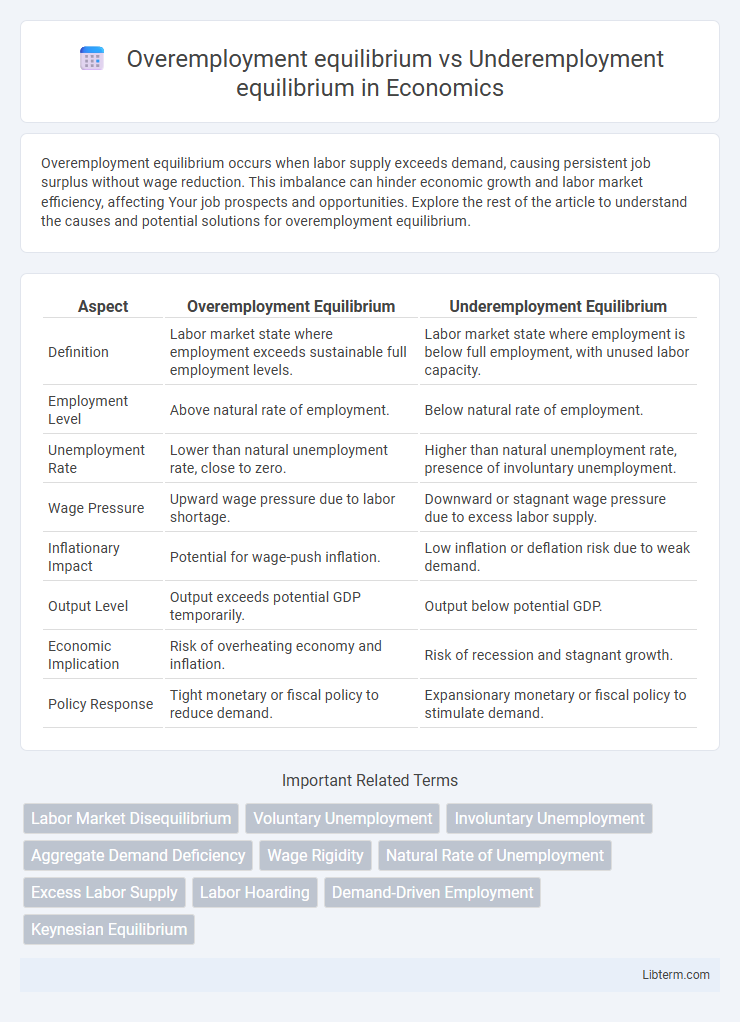Overemployment equilibrium occurs when labor supply exceeds demand, causing persistent job surplus without wage reduction. This imbalance can hinder economic growth and labor market efficiency, affecting Your job prospects and opportunities. Explore the rest of the article to understand the causes and potential solutions for overemployment equilibrium.
Table of Comparison
| Aspect | Overemployment Equilibrium | Underemployment Equilibrium |
|---|---|---|
| Definition | Labor market state where employment exceeds sustainable full employment levels. | Labor market state where employment is below full employment, with unused labor capacity. |
| Employment Level | Above natural rate of employment. | Below natural rate of employment. |
| Unemployment Rate | Lower than natural unemployment rate, close to zero. | Higher than natural unemployment rate, presence of involuntary unemployment. |
| Wage Pressure | Upward wage pressure due to labor shortage. | Downward or stagnant wage pressure due to excess labor supply. |
| Inflationary Impact | Potential for wage-push inflation. | Low inflation or deflation risk due to weak demand. |
| Output Level | Output exceeds potential GDP temporarily. | Output below potential GDP. |
| Economic Implication | Risk of overheating economy and inflation. | Risk of recession and stagnant growth. |
| Policy Response | Tight monetary or fiscal policy to reduce demand. | Expansionary monetary or fiscal policy to stimulate demand. |
Introduction to Employment Equilibriums
Employment equilibriums represent the balance points in labor markets where supply and demand for labor meet. Overemployment equilibrium occurs when labor demand exceeds supply, leading to full job utilization and potential labor shortages. Underemployment equilibrium arises when labor supply surpasses demand, causing insufficient job opportunities and underutilization of workforce skills.
Defining Overemployment Equilibrium
Overemployment equilibrium occurs when the labor market features a higher employment level than the natural rate, often driven by excessive demand for labor resulting in wage inflation and stretched production capacities. This state leads to labor shortages, increased work hours, and potential overheating of the economy. Unlike underemployment equilibrium, where resources are underutilized, overemployment equilibrium reflects an economy operating beyond its sustainable full employment threshold.
Understanding Underemployment Equilibrium
Underemployment equilibrium occurs when workers are employed in jobs that underutilize their skills or provide fewer hours than desired, causing an economic state where labor resources are inefficiently allocated. This condition often results from structural mismatches in the labor market, such as skill gaps or geographic immobility, leading to persistent unemployment despite available job vacancies. Understanding underemployment equilibrium is crucial for designing policies that improve workforce matching and raise overall productivity by addressing barriers to full employment.
Key Economic Indicators of Each Equilibrium
Overemployment equilibrium is characterized by low unemployment rates, rising wages, and increased labor force participation, often leading to inflationary pressure as demand for goods and services exceeds supply. Underemployment equilibrium features high underemployment rates, stagnant or declining wages, and reduced labor productivity, with excess labor supply failing to translate into sufficient job opportunities or income growth. Key economic indicators distinguishing these equilibria include the unemployment rate, labor force participation rate, wage growth, and inflation rate, reflecting the balance or imbalance between labor demand and supply.
Causes of Overemployment vs Underemployment
Overemployment arises from labor market rigidities, such as excessive job security regulations and wage floors that incentivize firms to retain more workers than necessary despite declining demand. Underemployment stems from insufficient labor demand, skill mismatches, and structural unemployment where workers are employed below their capacity or in part-time roles involuntarily. Macroeconomic shocks, technological advancements, and policy-driven distortions also play critical roles in shifting equilibrium towards either overemployment or underemployment conditions.
Impacts on Labor Markets and Wages
Overemployment equilibrium occurs when labor demand exceeds supply, leading to rising wages and decreased unemployment, which can drive inflationary pressures in the economy. Underemployment equilibrium results from labor supply surpassing demand, causing stagnant or declining wages and increased unemployment or underutilized labor skills. These equilibria significantly impact labor market dynamics, influencing job availability, wage growth, and overall economic productivity.
Macroeconomic Consequences and Policy Implications
Overemployment equilibrium occurs when labor demand exceeds supply, causing inflationary pressures and wage growth that can reduce unemployment temporarily but risk overheating the economy, whereas underemployment equilibrium reflects persistent labor market slack with idle resources and suppressed wages, leading to stagnation and lower aggregate demand. Macroeconomic consequences of overemployment include rising inflation and potential asset bubbles, while underemployment triggers unemployment persistence, lower productivity, and fiscal deficits due to reduced tax revenues. Policy implications suggest tightening monetary policy and supply-side reforms in overemployment scenarios, contrasted with expansive fiscal and monetary interventions, including job training programs and unemployment benefits, to stimulate demand and improve labor market flexibility during underemployment.
Case Studies: Real-World Examples
Case studies in overemployment equilibrium reveal sectors like healthcare and education where workforce surpluses coexist with high job satisfaction despite limited job openings, exemplified by Japan's nursing industry. Underemployment equilibrium often appears in gig economy platforms such as Uber, where workers face inconsistent hours and income instability paralleling cases in the U.S. and India. Examining these real-world scenarios demonstrates how market imbalances affect labor supply-demand dynamics and influence policy interventions targeting employment quality and economic growth.
Transitioning Between Employment Equilibriums
Transitioning between overemployment equilibrium and underemployment equilibrium involves balancing labor market dynamics where overemployment indicates labor shortage driving wages up, while underemployment reflects surplus labor depressing wages and productivity. Effective policy measures, such as flexible workforce allocation and targeted skill development, facilitate smooth adjustments by addressing mismatches in labor supply and demand. Monitoring real-time employment data and economic indicators accelerates identification of equilibrium shifts, enabling proactive interventions to stabilize employment levels.
Strategies for Achieving Balanced Employment Equilibrium
Companies achieve balanced employment equilibrium by implementing flexible work arrangements and continuous skills development programs to align labor demand with workforce capacities. Strategic workforce planning utilizes data analytics to anticipate market shifts and adjust hiring or training initiatives accordingly, preventing both overemployment and underemployment scenarios. Government policies promoting reskilling and incentivizing industries with labor shortages complement corporate strategies to sustain optimal employment levels.
Overemployment equilibrium Infographic

 libterm.com
libterm.com